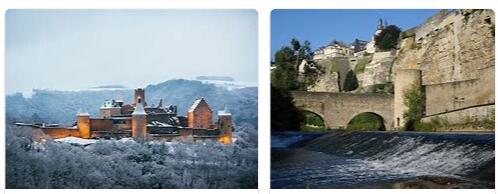A small Western European state, Luxembourg has been disputed by neighboring powers since its constitution (10th century). After alternating vicissitudes of annexations and territorial divisions, Luxembourg was established in the Grand Duchy (1815), acquiring full independence in 1867. A country with a pro-European vocation, Luxembourg participated directly in the major political-economic events of the continent, first promoting the institution of Benelux, thus becoming an active member of what would become the European Union, which in Luxembourg, the capital of the Grand Duchy, has placed the headquarters of various community bodies. Having successfully faced the transition from an industrial economy (based on the steel sector) to an economy oriented to the tertiary sector, according to andyeducation, Luxembourg is today one of the most stable and richest countries in the world, relying on the solidity of the banking and financial and on the influx of substantial foreign investment thanks to favorable banking and tax legislation.
TERRITORY: PHYSICAL GEOGRAPHY
The territory of Luxembourg, which is largely identified with the other lands that form the watershed between the Meuse and the Moselle, can be morphologically divided into two regions: the northern one, which is approx. a third of the total, forms the Ösling (or Eisling), the southern one, the Gutland. . On average 400-500 m high (it is the highest area of the country), crossed by numerous rivers, tributaries of the Sûre (Sauer), the Ösling occupies a portion of the Ardennes massif, whose dense woodlands in the far north they alternate with vast areas of moors and moors. The Gutland stretches to the south, the “good country”, an extension of the Lorraine lowland, characterized by slightly undulating plains, wide valleys dense with crops and inhabited areas and by a rich subsoil: in the southwestern extremity those iron minerals emerge on which modern Luxembourg has founded its prosperity. The main rivers that cross the country are the Alzette and the Sûre, the latter being a tributary of the Moselle that marks the eastern border with Germany for 40 km. The climate is continental, with cool summers (averages of 16 ° C) and rigid winters with averages below zero: rainfall, which is around 700 mm per year, is more pronounced in the summer months. Compared to Ösling, Gutland has less severe winters (January average of 2 ° C) and average summer temperatures of 18-19 ° C.
TERRITORY: ENVIRONMENT
Despite its modest size, Luxembourg is a highly industrialized country and the per capita consumption of electricity is among the highest in the world. Due to the considerable emissions of polluting substances, the environmental problem arises in all its gravity, especially as regards the problem of acid rain that threatens the large forest areas that occupy a third of the country’s surface, as well as the atmospheric and water pollution of the urban centers. To safeguard the environment, 16.6% of the territory has been placed under protection through the establishment of parks and protected areas, including the Our Natural Park, located in the Ardennes region, and the Upper-Sûre Natural Park. Rich in deciduous forests, wetlands, peat bogs and reeds, these protected areas preserve a rare floristic heritage (orchids, rushes, sedges) and fauna (black storks, kingfishers, snipe, otters, badgers, wild cats and bats). Luxembourg has ratified international environmental agreements on air pollution, biodiversity, climate change, desertification, endangered species, toxic and harmful waste, abolition of nuclear testing and protection of ozonosphere.
CULTURE: GENERAL INFORMATION
A region of passage and transition, Luxembourg owes much of its cultural identity to the contributions of neighboring countries and to the influence suffered in particular by the two great civilizations with which it has come into contact over the course of history: the Roman and the Germanic. Particular the nature of literature which, characterized by multilingualism, presents works written in Luxembourgish, French and German: three literatures, therefore, each of which can boast a centuries-old tradition. Among the authors who have contributed to the success of literature in the national language, whose beginnings the historians of literature place in the nineteenth century, are Michel Rodange, Guy Rewenig and Roger Manderscheid. To underline, for the purposes of a national cultural awareness, also the Victor Hugo, Racine, Goethe, Michelet, Gide, Chateaubriand and Claudel. Official language is Luxembourgish, a kind of dialect of Germanic origin with French and Dutch linguistic elements, used mainly in everyday communications. French (language of administration and courts) and German (in trade and in the press) are also very popular. Luxembourg is home to important museums, testimony both to the country’s historical and cultural heritage and to contemporary artistic expressions. The most important is undoubtedly the National Museum of History and Art, located in the capital, which in addition to providing documentary material on the history of Luxembourg is often the promoter of important art exhibitions.
